Nicholas P. Cheremisinoff. Handbook of Solid Waste Management and Waste Minimization Technologies
Подождите немного. Документ загружается.

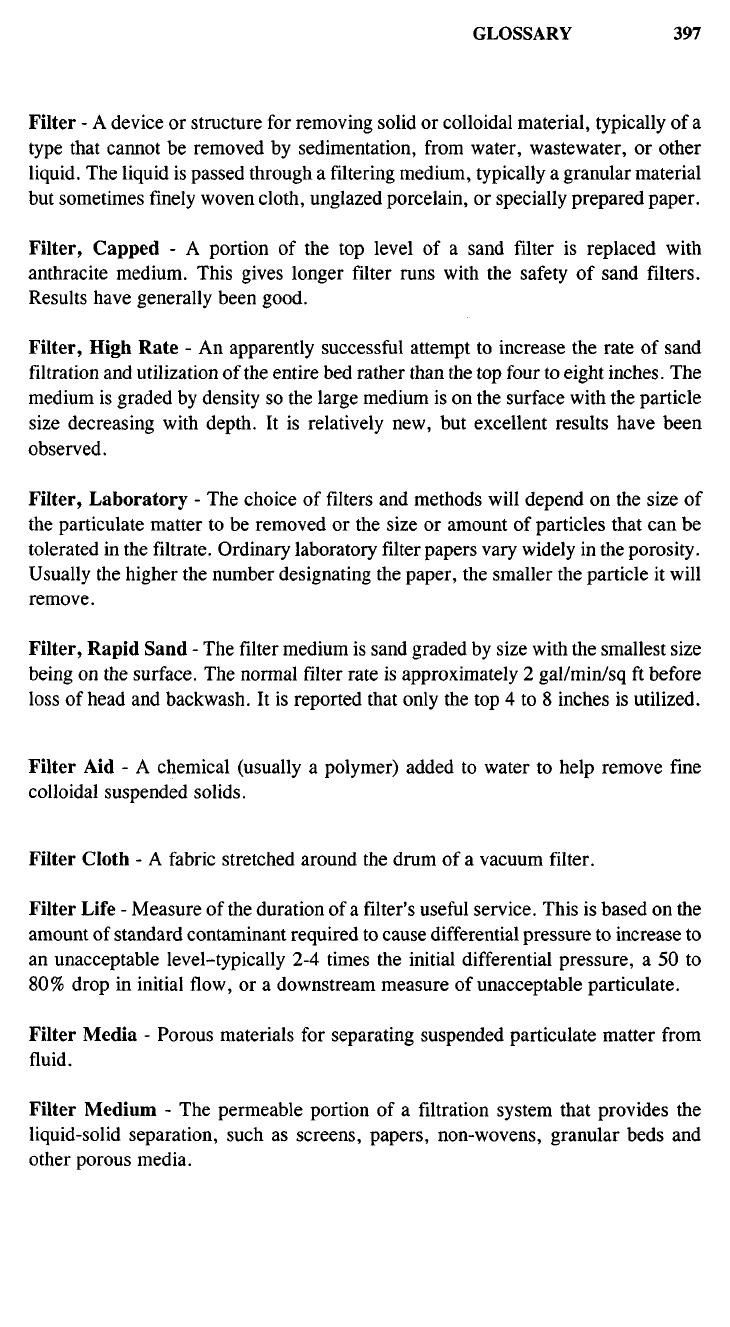
Filter - A device or structure for removing solid or colloidal material, typically of a
type that cannot be removed by sedimentation, from water, wastewater, or other
liquid. The liquid is passed through a filtering medium, typically a granular material
but sometimes finely woven cloth, unglazed porcelain, or specially prepared paper.
Filter, Capped - A portion of the top level of a sand filter is replaced with
anthracite medium. This gives longer filter runs with the safety of sand filters.
Results have generally been good.
Filter, High Rate - An apparently successful attempt to increase the rate of sand
filtration and utilization of the entire bed rather than the top four to eight inches. The
medium is graded by density so the large medium is on the surface with the particle
size decreasing with depth. It is relatively new, but excellent results have been
observed.
Filter, Laboratory - The choice of filters and methods will depend on the size of
the paniculate matter to be removed or the size or amount of particles that can be
tolerated in the filtrate. Ordinary laboratory filter papers vary widely in the porosity.
Usually the higher the number designating the paper, the smaller the particle it will
remove.
Filter, Rapid Sand - The filter medium is sand graded by size with the smallest size
being on the surface. The normal filter rate is approximately 2 gal/min/sq ft before
loss of head and backwash. It is reported that only the top 4 to 8 inches is utilized.
Filter Aid - A chemical (usually a polymer) added to water to help remove fine
colloidal suspended solids.
Filter Cloth - A fabric stretched around the drum of a vacuum filter.
Filter Life - Measure of the duration of a filter's useful service. This is based on the
amount of standard contaminant required to cause differential pressure to increase to
an unacceptable level-typically 2-4 times the initial differential pressure, a 50 to
80%
drop in initial flow, or a downstream measure of unacceptable particulate.
Filter Media - Porous materials for separating suspended particulate matter from
fluid.
Filter Medium - The permeable portion of a filtration system that provides the
liquid-solid separation, such as screens, papers, non-wovens, granular beds and
other porous media.
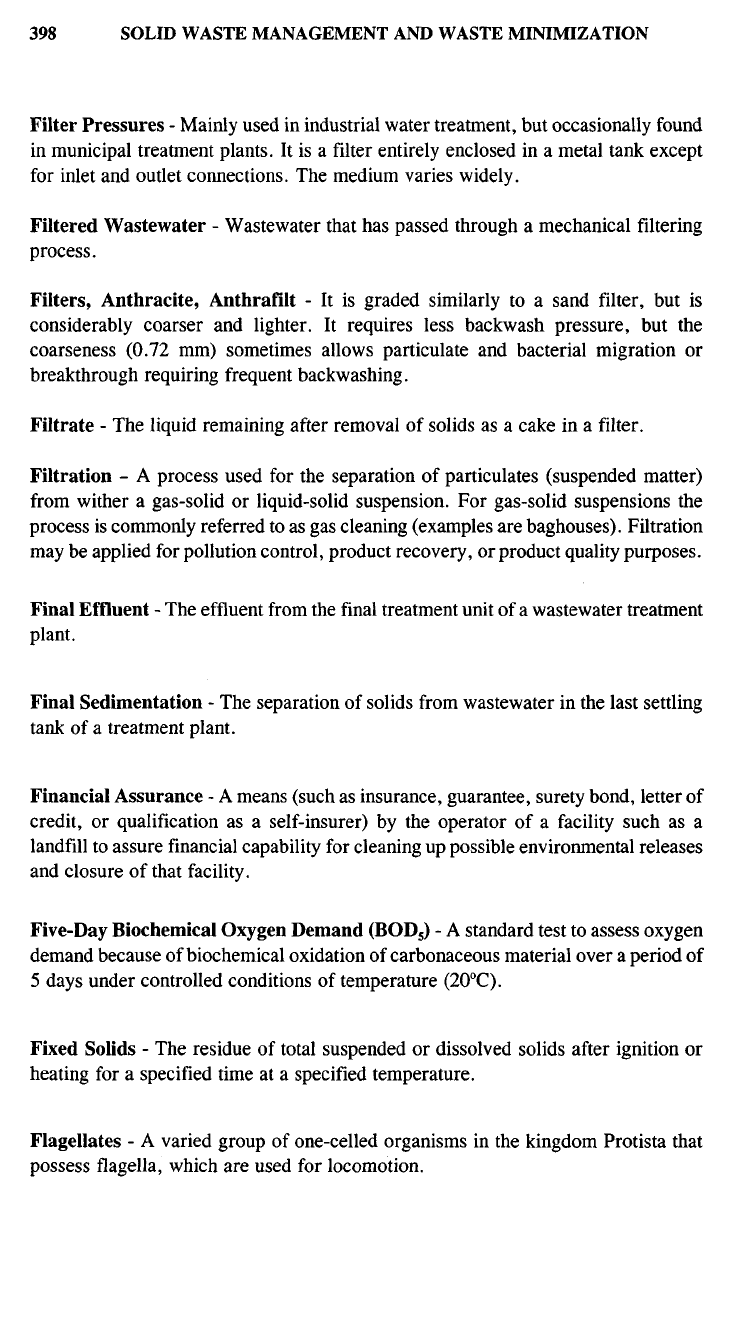
Filter Pressures - Mainly used in industrial water treatment, but occasionally found
in municipal treatment plants. It is a filter entirely enclosed in a metal tank except
for inlet and outlet connections. The medium varies widely.
Filtered Wastewater - Wastewater that has passed through a mechanical filtering
process.
Filters, Anthracite, Anthrafilt - It is graded similarly to a sand filter, but is
considerably coarser and lighter. It requires less backwash pressure, but the
coarseness (0.72 mm) sometimes allows paniculate and bacterial migration or
breakthrough requiring frequent backwashing.
Filtrate - The liquid remaining after removal of solids as a cake in a filter.
Filtration - A process used for the separation of particulates (suspended matter)
from wither a gas-solid or liquid-solid suspension. For gas-solid suspensions the
process is commonly referred to as gas cleaning (examples are baghouses). Filtration
may be applied for pollution control, product recovery, or product quality purposes.
Final Effluent - The effluent from the final treatment unit of a wastewater treatment
plant.
Final Sedimentation - The separation of solids from wastewater in the last settling
tank of a treatment plant.
Financial Assurance - A means (such as insurance, guarantee, surety bond, letter of
credit, or qualification as a self-insurer) by the operator of a facility such as a
landfill to assure financial capability for cleaning up possible environmental releases
and closure of that facility.
Five-Day Biochemical Oxygen Demand (BOD
5
) - A standard test to assess oxygen
demand because of biochemical oxidation of carbonaceous material over a period of
5 days under controlled conditions of temperature (2O
0
C).
Fixed Solids - The residue of total suspended or dissolved solids after ignition or
heating for a specified time at a specified temperature.
Flagellates - A varied group of one-celled organisms in the kingdom Protista that
possess flagella, which are used for locomotion.
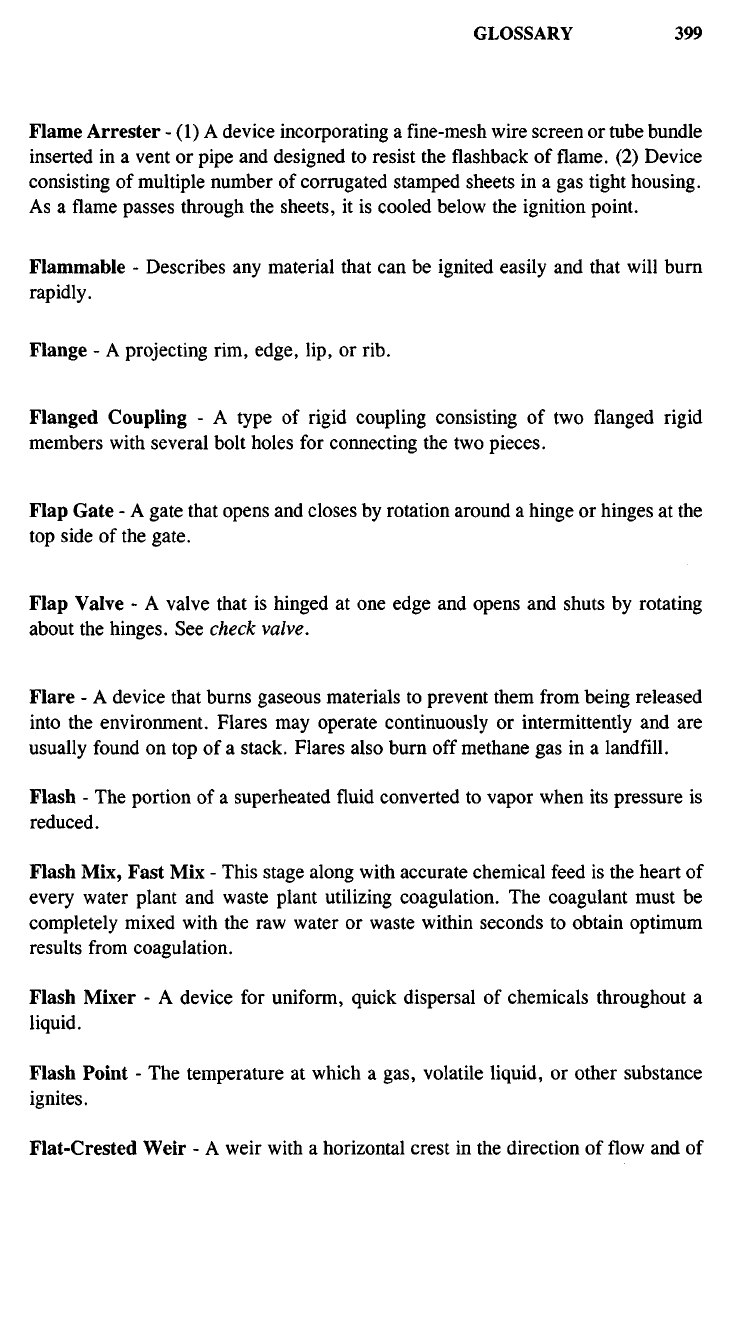
Flame Arrester -(I)A device incorporating a fine-mesh wire screen or tube bundle
inserted in a vent or pipe and designed to resist the flashback of flame. (2) Device
consisting of multiple number of corrugated stamped sheets in a gas tight housing.
As a flame passes through the sheets, it is cooled below the ignition point.
Flammable - Describes any material that can be ignited easily and that will burn
rapidly.
Flange - A projecting rim, edge, lip, or rib.
Flanged Coupling - A type of rigid coupling consisting of two flanged rigid
members with several bolt holes for connecting the two pieces.
Flap Gate - A gate that opens and closes by rotation around a hinge or hinges at the
top side of the gate.
Flap Valve - A valve that is hinged at one edge and opens and shuts by rotating
about the hinges. See check valve.
Flare - A device that burns gaseous materials to prevent them from being released
into the environment. Flares may operate continuously or intermittently and are
usually found on top of a stack. Flares also burn off methane gas in a landfill.
Flash - The portion of a superheated fluid converted to vapor when its pressure is
reduced.
Flash Mix, Fast Mix - This stage along with accurate chemical feed is the heart of
every water plant and waste plant utilizing coagulation. The coagulant must be
completely mixed with the raw water or waste within seconds to obtain optimum
results from coagulation.
Flash Mixer - A device for uniform, quick dispersal of chemicals throughout a
liquid.
Flash Point - The temperature at which a gas, volatile liquid, or other substance
ignites.
Flat-Crested Weir - A weir with a horizontal crest in the direction of flow and of
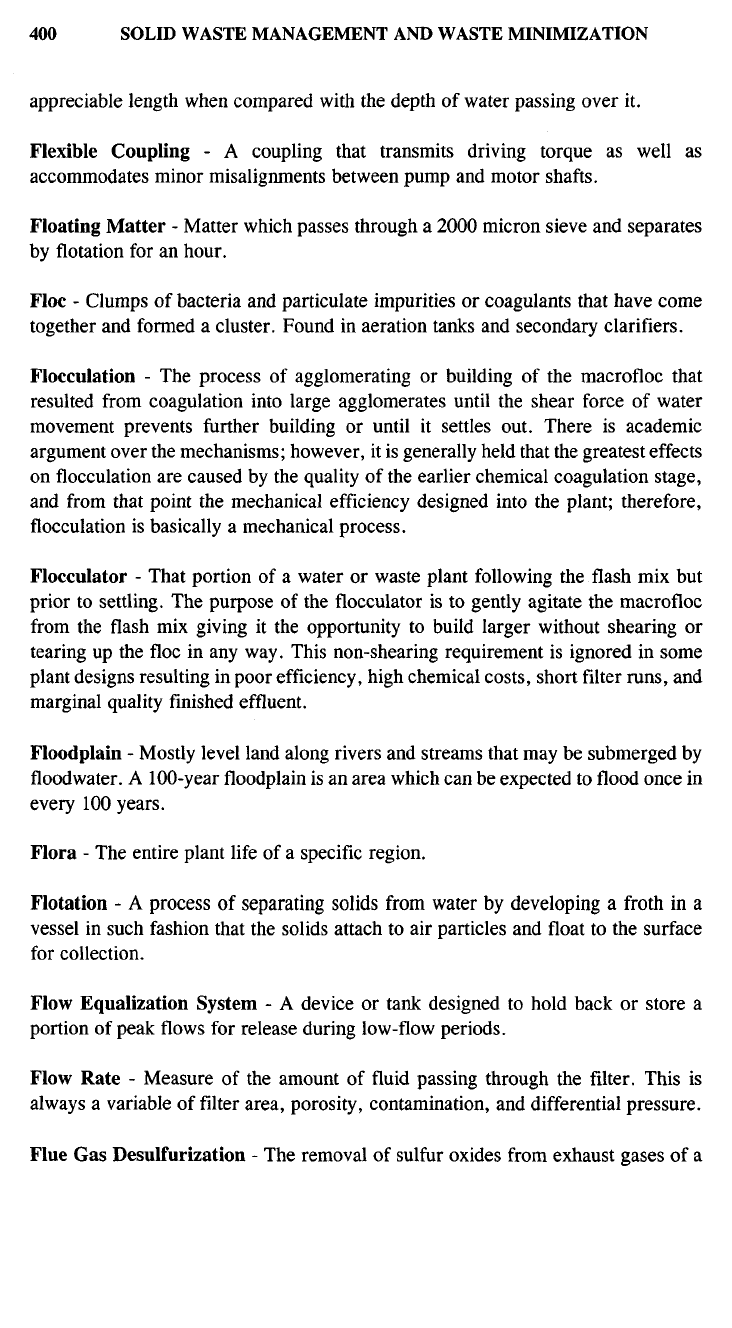
appreciable length when compared with the depth of water passing over it.
Flexible Coupling - A coupling that transmits driving torque as well as
accommodates minor misalignments between pump and motor shafts.
Floating Matter - Matter which passes through a 2000 micron sieve and separates
by flotation for an hour.
Floe - Clumps of bacteria and particulate impurities or coagulants that have come
together and formed a cluster. Found in aeration tanks and secondary clarifiers.
Flocculation - The process of agglomerating or building of the macrofloc that
resulted from coagulation into large agglomerates until the shear force of water
movement prevents further building or until it settles out. There is academic
argument over the mechanisms; however, it is generally held that the greatest effects
on flocculation are caused by the quality of the earlier chemical coagulation stage,
and from that point the mechanical efficiency designed into the plant; therefore,
flocculation is basically a mechanical process.
Flocculator - That portion of a water or waste plant following the flash mix but
prior to settling. The purpose of the flocculator is to gently agitate the macrofloc
from the flash mix giving it the opportunity to build larger without shearing or
tearing up the floe in any way. This non-shearing requirement is ignored in some
plant designs resulting in poor efficiency, high chemical costs, short filter runs, and
marginal quality finished effluent.
Floodplain - Mostly level land along rivers and streams that may be submerged by
floodwater. A 100-year floodplain is an area which can be expected to flood once in
every 100 years.
Flora - The entire plant life of a specific region.
Flotation - A process of separating solids from water by developing a froth in a
vessel in such fashion that the solids attach to air particles and float to the surface
for collection.
Flow Equalization System - A device or tank designed to hold back or store a
portion of peak flows for release during low-flow periods.
Flow Rate - Measure of the amount of fluid passing through the filter. This is
always a variable of filter area, porosity, contamination, and differential pressure.
Flue Gas Desulfurization - The removal of sulfur oxides from exhaust gases of a
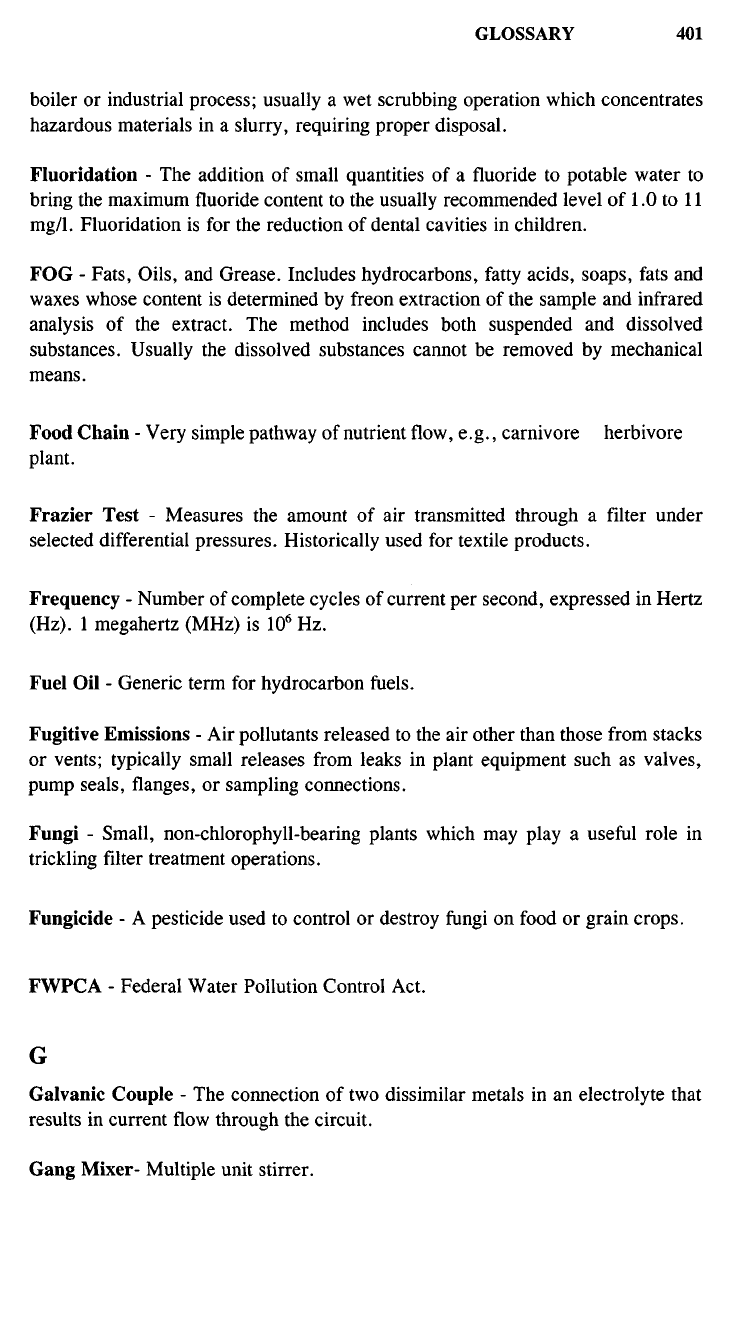
boiler or industrial process; usually a wet scrubbing operation which concentrates
hazardous materials in a slurry, requiring proper disposal.
Fluoridation - The addition of small quantities of a fluoride to potable water to
bring the maximum fluoride content to the usually recommended level of 1.0 to 11
mg/1.
Fluoridation is for the reduction of dental cavities in children.
FOG - Fats, Oils, and Grease. Includes hydrocarbons, fatty acids, soaps, fats and
waxes whose content is determined by freon extraction of the sample and infrared
analysis of the extract. The method includes both suspended and dissolved
substances. Usually the dissolved substances cannot be removed by mechanical
means.
Food Chain - Very simple pathway of nutrient flow, e.g., carnivore herbivore
plant.
Frazier Test - Measures the amount of air transmitted through a filter under
selected differential pressures. Historically used for textile products.
Frequency - Number of complete cycles of current per second, expressed in Hertz
(Hz).
1 megahertz (MHz) is 10
6
Hz.
Fuel Oil - Generic term for hydrocarbon fuels.
Fugitive Emissions - Air pollutants released to the air other than those from stacks
or vents; typically small releases from leaks in plant equipment such as valves,
pump seals, flanges, or sampling connections.
Fungi - Small, non-chlorophyll-bearing plants which may play a useful role in
trickling filter treatment operations.
Fungicide - A pesticide used to control or destroy fungi on food or grain crops.
FWPCA - Federal Water Pollution Control Act.
G
Galvanic Couple - The connection of two dissimilar metals in an electrolyte that
results in current flow through the circuit.
Gang Mixer- Multiple unit stirrer.
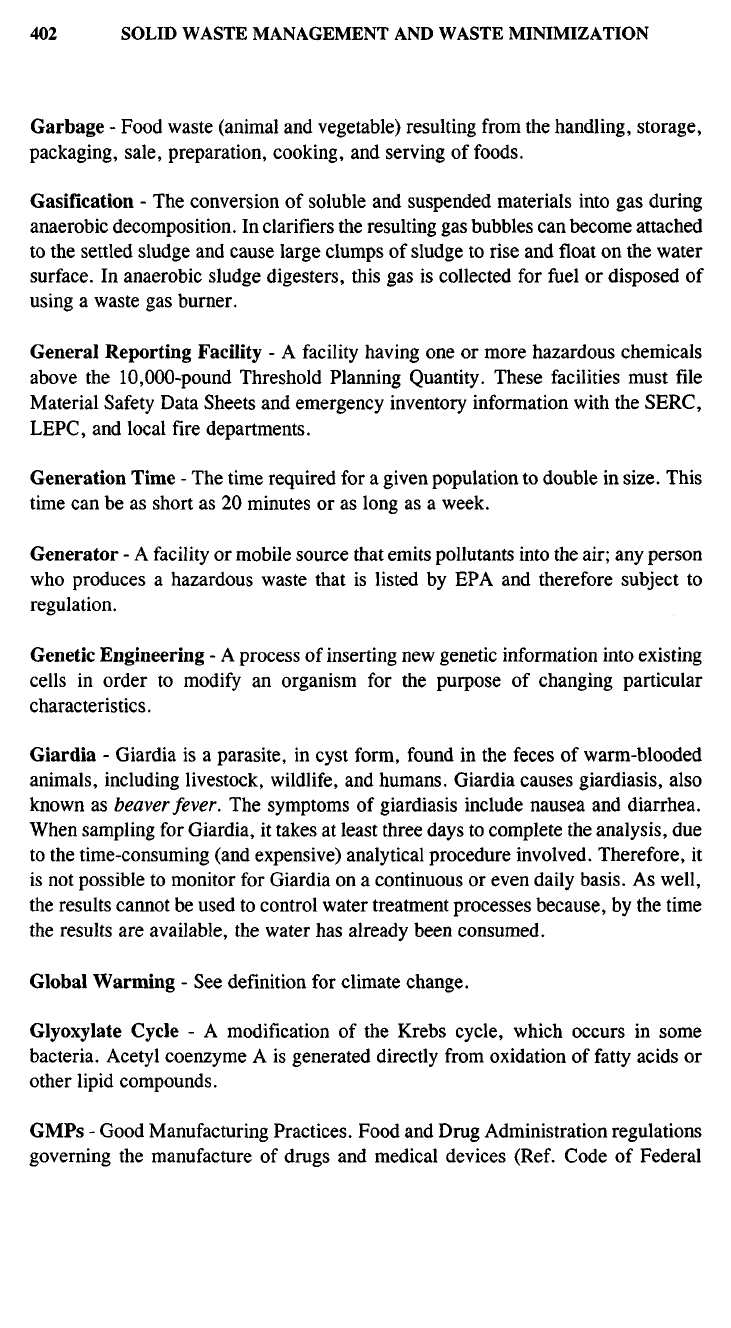
Garbage - Food waste (animal and vegetable) resulting from the handling, storage,
packaging, sale, preparation, cooking, and serving of foods.
Gasification - The conversion of soluble and suspended materials into gas during
anaerobic decomposition. In clarifiers the resulting gas bubbles can become attached
to the settled sludge and cause large clumps of sludge to rise and float on the water
surface. In anaerobic sludge digesters, this gas is collected for fuel or disposed of
using a waste gas burner.
General Reporting Facility - A facility having one or more hazardous chemicals
above the 10,000-pound Threshold Planning Quantity. These facilities must file
Material Safety Data Sheets and emergency inventory information with the SERC,
LEPC, and local fire departments.
Generation Time - The time required for a given population to double in size. This
time can be as short as 20 minutes or as long as a week.
Generator - A facility or mobile source that emits pollutants into the air; any person
who produces a hazardous waste that is listed by EPA and therefore subject to
regulation.
Genetic Engineering - A process of inserting new genetic information into existing
cells in order to modify an organism for the purpose of changing particular
characteristics.
Giardia - Giardia is a parasite, in cyst form, found in the feces of warm-blooded
animals, including livestock, wildlife, and humans. Giardia causes giardiasis, also
known as beaver fever. The symptoms of giardiasis include nausea and diarrhea.
When sampling for Giardia, it takes at least three days to complete the analysis, due
to the time-consuming (and expensive) analytical procedure involved. Therefore, it
is not possible to monitor for Giardia on a continuous or even daily basis. As well,
the results cannot be used to control water treatment processes because, by the time
the results are available, the water has already been consumed.
Global Warming - See definition for climate change.
GIyoxylate Cycle - A modification of the Krebs cycle, which occurs in some
bacteria. Acetyl coenzyme A is generated directly from oxidation of fatty acids or
other Hpid compounds.
GMPs - Good Manufacturing Practices. Food and Drug Administration regulations
governing the manufacture of drugs and medical devices (Ref. Code of Federal
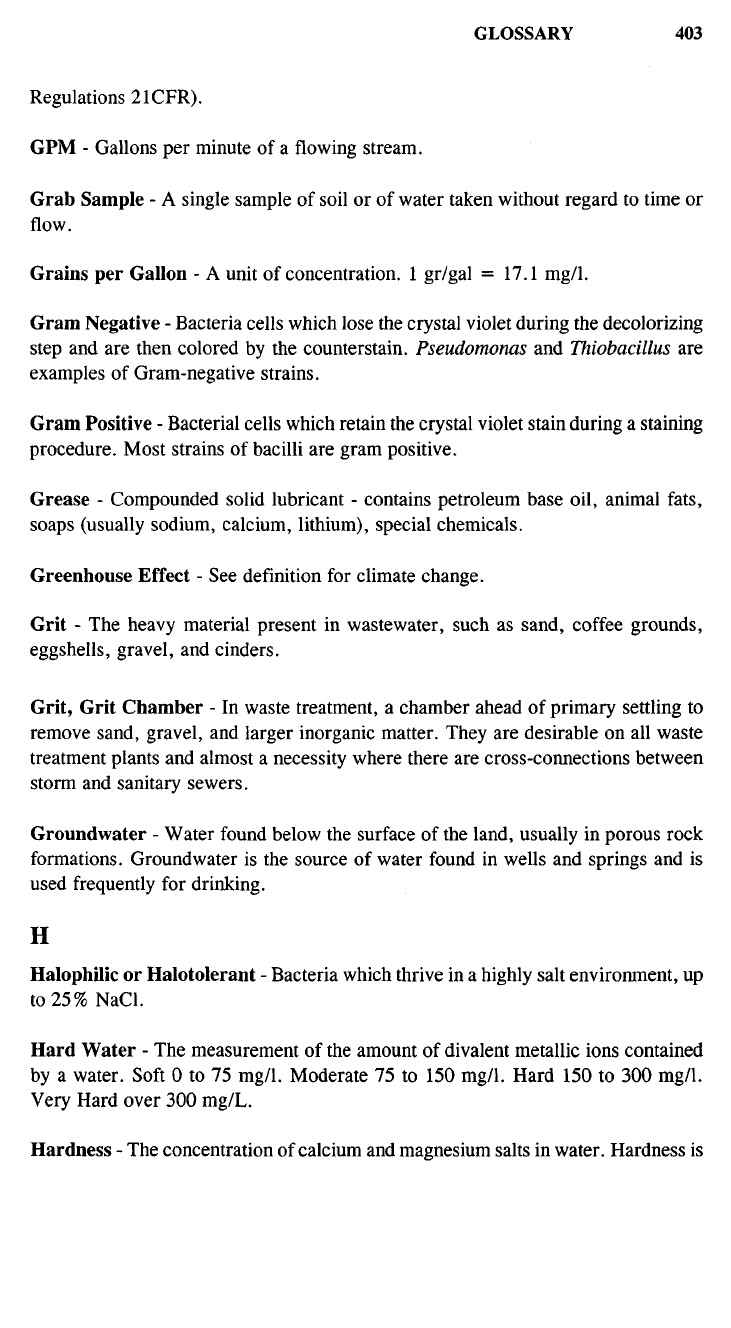
Regulations 2 ICFR).
GPM - Gallons per minute of a flowing stream.
Grab Sample - A single sample of soil or of water taken without regard to time or
flow.
Grains per Gallon - A unit of concentration. 1 gr/gal = 17.1 mg/1.
Gram Negative - Bacteria cells which lose the crystal violet during the decolorizing
step and are then colored by the counter
stain.
Pseudomonas and Thiobacillus are
examples of Gram-negative strains.
Gram Positive - Bacterial cells which retain the crystal violet stain during a staining
procedure. Most strains of bacilli are gram positive.
Grease - Compounded solid lubricant - contains petroleum base oil, animal fats,
soaps (usually sodium, calcium, lithium), special chemicals.
Greenhouse Effect - See definition for climate change.
Grit - The heavy material present in wastewater, such as sand, coffee grounds,
eggshells, gravel, and cinders.
Grit, Grit Chamber - In waste treatment, a chamber ahead of primary settling to
remove sand, gravel, and larger inorganic matter. They are desirable on all waste
treatment plants and almost a necessity where there are cross-connections between
storm and sanitary sewers.
Groundwater - Water found below the surface of the land, usually in porous rock
formations. Groundwater is the source of water found in wells and springs and is
used frequently for drinking.
H
Halophilic or Halotolerant - Bacteria which thrive in a highly salt environment, up
to 25% NaCl.
Hard Water - The measurement of the amount of divalent metallic ions contained
by a water. Soft 0 to 75 mg/1. Moderate 75 to 150 mg/1. Hard 150 to 300 mg/1.
Very Hard over 300 mg/L.
Hardness - The concentration of calcium and magnesium salts in water. Hardness is
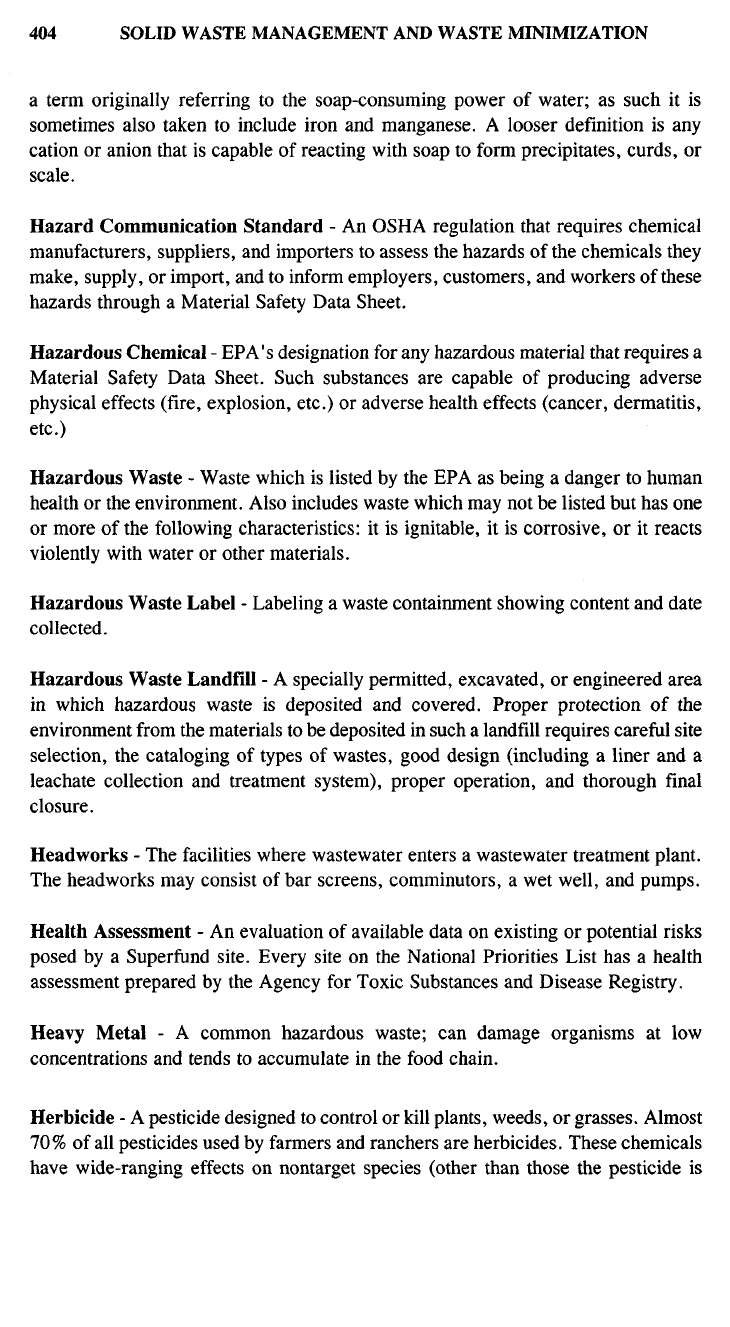
a term originally referring to the soap-consuming power of water; as such it is
sometimes also taken to include iron and manganese. A looser definition is any
cation or anion that is capable of reacting with soap to form precipitates, curds, or
scale.
Hazard Communication Standard - An OSHA regulation that requires chemical
manufacturers, suppliers, and importers to assess the hazards of the chemicals they
make, supply, or import, and to inform employers, customers, and workers of these
hazards through a Material Safety Data Sheet.
Hazardous Chemical - EPA 's designation for any hazardous material that requires a
Material Safety Data Sheet. Such substances are capable of producing adverse
physical effects (fire, explosion, etc.) or adverse health effects (cancer, dermatitis,
etc.)
Hazardous Waste - Waste which is listed by the EPA as being a danger to human
health or the environment. Also includes waste which may not be listed but has one
or more of the following characteristics: it is ignitable, it is corrosive, or it reacts
violently with water or other materials.
Hazardous Waste Label - Labeling a waste containment showing content and date
collected.
Hazardous Waste Landfill - A specially permitted, excavated, or engineered area
in which hazardous waste is deposited and covered. Proper protection of the
environment from the materials to be deposited in such a landfill requires careful site
selection, the cataloging of types of wastes, good design (including a liner and a
leachate collection and treatment system), proper operation, and thorough final
closure.
Headworks - The facilities where waste water enters a waste water treatment plant.
The headworks may consist of bar screens, comminutors, a wet well, and pumps.
Health Assessment - An evaluation of available data on existing or potential risks
posed by a Superfund site. Every site on the National Priorities List has a health
assessment prepared by the Agency for Toxic Substances and Disease Registry.
Heavy Metal - A common hazardous waste; can damage organisms at low
concentrations and tends to accumulate in the food chain.
Herbicide - A pesticide designed to control or kill plants, weeds, or grasses. Almost
70%
of all pesticides used by farmers and ranchers are herbicides. These chemicals
have wide-ranging effects on nontarget species (other than those the pesticide is

meant to control).
Heterotroph - A microorganism which uses organic matter for energy and growth.
High-Rate Treatment - Removes heavier particles and floatables but at a lower
efficiency than primary or enhanced primary treatment.
House Sewer - The pipeline connecting the house and drain and the septic tank.
Household or Domestic Waste - Solid waste, composed of garbage and rubbish,
which normally originates from residential, private households, or apartment
buildings. Domestic waste may contain a significant amount of toxic or hazardous
waste from improperly discarded pesticides, paints, batteries, and cleaners.
HRT - Hours of Retention Time.
Humidification - The addition of water vapor to air.
Humus - The dark organic material in soils, produced by the decomposition of plant
matter. The matter that remains after the bulk of detritus has been consumed (leaves,
roots).
Humus mixes with top layers of soil (rock particles), supplies some of the
nutrients needed by plants, and increases acidity of soil; inorganic nutrients more
soluble under acidic conditions, become more available, e.g., wheat grows best at
pH 5.5 to 7.0. Humus modifies soil texture, creating a loose, crumbly texture that
allows water to soak in and nutrients to be retained; it permits air to be incorporated
into soil.
Hydraulic Conductivity - The ease of movement of water through the soil relative to
a potential gradient.
Hydraulic Gradient - The direction of ground water flow due to changes in the depth
of the water table.
Hydraulic Load - The gallons of flow per day per square foot of filter surface area.
The use of metric measurement is also accepted.
Hydraulic Loading - Hydraulic loading refers to the flows (MGD or m
3
/day) to a
treatment plant or treatment process.
Hydrocarbons - Chemicals that consist entirely of hydrogen and carbon.
Hydrocarbons contribute to air pollution problems, such as smog.
Hydrogen Sulfide Gas - Hydrogen sulfide is a gas with a rotten
Qgg
odor. This gas
is produced under anaerobic conditions. Hydrogen sulfide is particularly dangerous
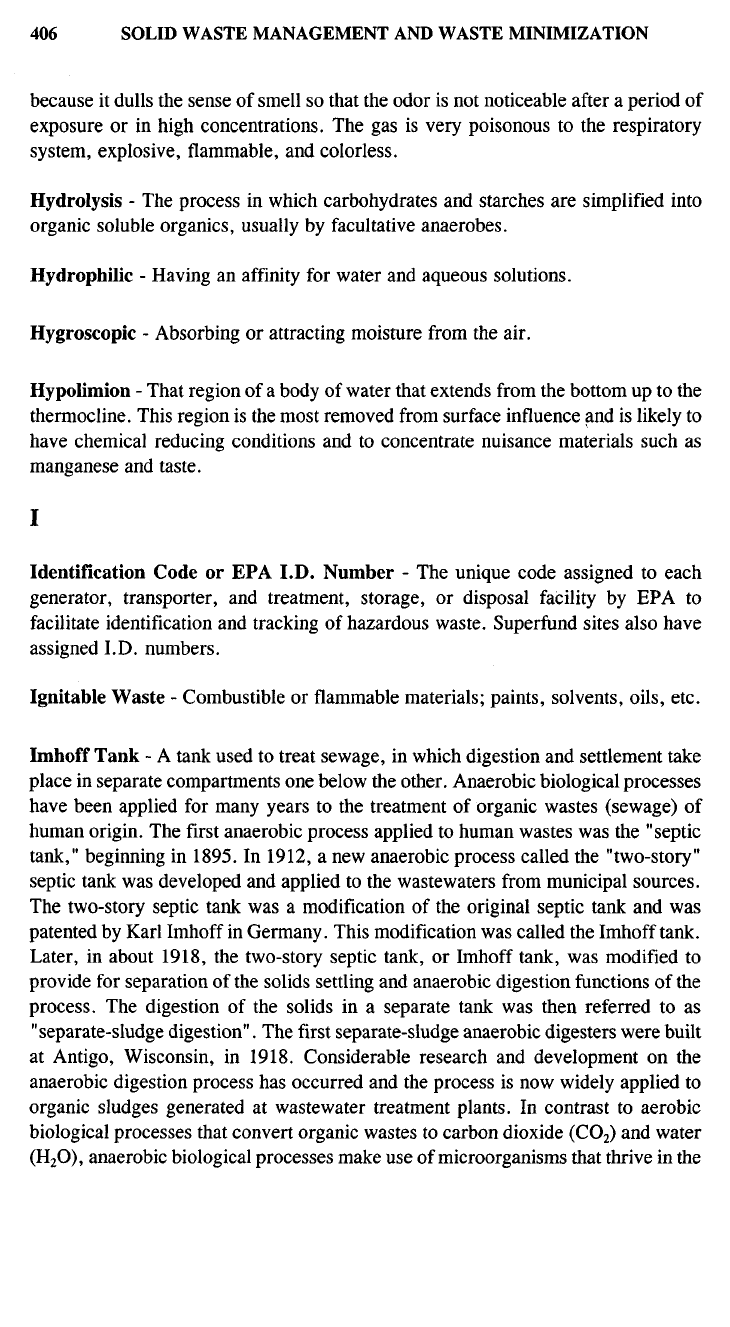
because it dulls the sense of smell so that the odor is not noticeable after a period of
exposure or in high concentrations. The gas is very poisonous to the respiratory
system, explosive, flammable, and colorless.
Hydrolysis - The process in which carbohydrates and starches are simplified into
organic soluble organics, usually by facultative anaerobes.
Hydrophilic - Having an affinity for water and aqueous solutions.
Hygroscopic - Absorbing or attracting moisture from the air.
Hypolimion - That region of a body of water that extends from the bottom up to the
thermocline. This region is the most removed from surface influence and is likely to
have chemical reducing conditions and to concentrate nuisance materials such as
manganese and taste.
I
Identification Code or EPA LD. Number - The unique code assigned to each
generator, transporter, and treatment, storage, or disposal facility by EPA to
facilitate identification and tracking of hazardous waste. Superfund sites also have
assigned LD. numbers.
Ignitable Waste - Combustible or flammable materials; paints, solvents, oils, etc.
Imhoff Tank - A tank used to treat sewage, in which digestion and settlement take
place in separate compartments one below the other. Anaerobic biological processes
have been applied for many years to the treatment of organic wastes (sewage) of
human origin. The first anaerobic process applied to human wastes was the "septic
tank," beginning in 1895. In 1912, a new anaerobic process called the "two-story"
septic tank was developed and applied to the wastewaters from municipal sources.
The two-story septic tank was a modification of the original septic tank and was
patented by Karl Imhoff in Germany. This modification was called the Imhoff tank.
Later, in about 1918, the two-story septic tank, or Imhoff tank, was modified to
provide for separation of the solids settling and anaerobic digestion functions of the
process. The digestion of the solids in a separate tank was then referred to as
"separate-sludge digestion". The first separate-sludge anaerobic digesters were built
at Antigo, Wisconsin, in 1918. Considerable research and development on the
anaerobic digestion process has occurred and the process is now widely applied to
organic sludges generated at waste water treatment plants. In contrast to aerobic
biological processes that convert organic wastes to carbon dioxide (CO
2
) and water
(H
2
O),
anaerobic biological processes make use of microorganisms that thrive in the
